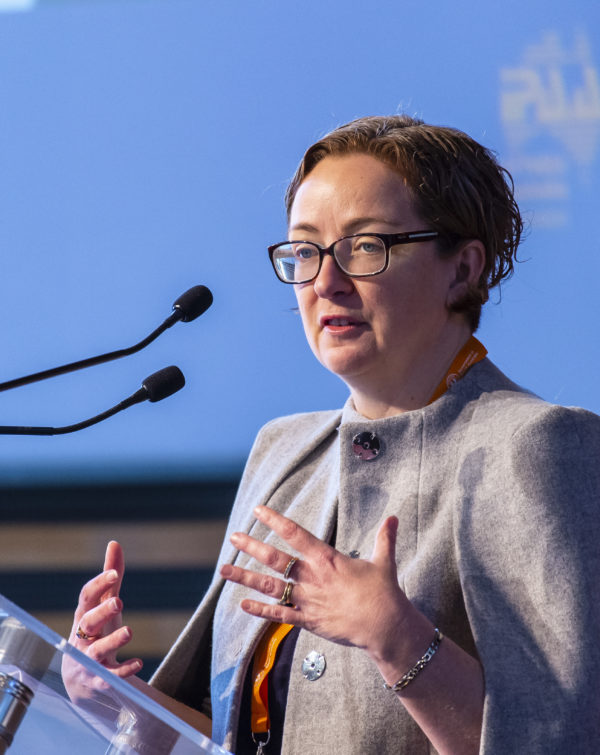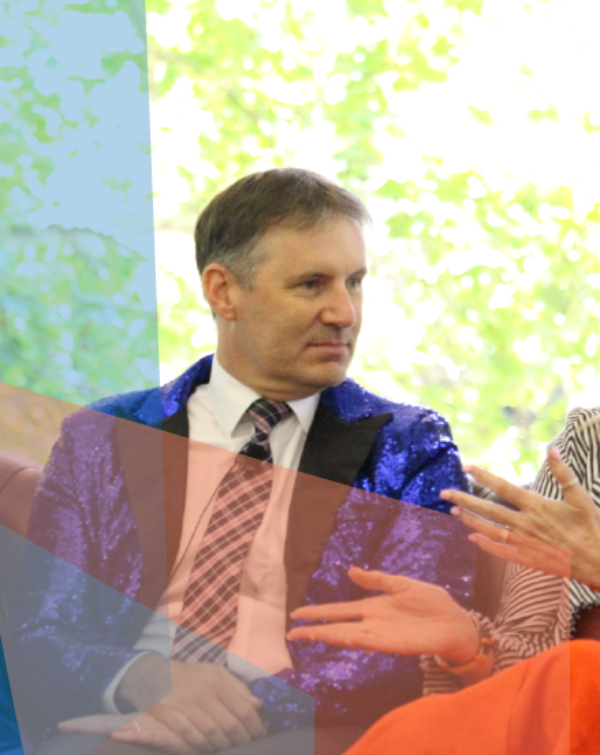
Satya Nadella is a man who has reached the absolute peak of his profession. At just 52 years of age he has been the CEO of global tech giant Microsoft Corporation for almost 6 years.
On 21 November Satya Nadella joined David Thodey AO in a wide-ranging conversation on Ngunnawal Country in the Great Hall at Parliament House in Canberra. He spoke with an audience of Australia’s most senior leaders from the Australian Public Service, the ACT Public Service, professional service networks and tech firms.
The IPAA ACT luncheon was hosted by Renée Leon PSM, Secretary of the Department of Human Services, representing IPAA ACT President and the Secretary of the Treasury, Dr Stephen Kennedy PSM, who was travelling interstate with the Treasurer.
Despite the extraordinary success Microsoft has achieved under Satya Nadella’s leadership — a fourfold rise in its stock price being but one KPI — it is clear from his energy, passion and moral compass that his ambition for Microsoft, and the role it can play for the good of society, is unconstrained:
— The sense of purpose and mission of Microsoft under Satya? To empower every person and organisation on the planet to achieve more.
— Its mindset? One of growth.
— Its culture? One which seeks to ‘learn it all’ rather than to ‘know it all’.
Satya reflected on an important lesson he learned while playing for his high school cricket team.
He had just finished a spell of off-spin — ‘bowling some real trash’ — and was replaced by his captain who brought himself on to get a breakthrough.
What surprised Satya was that as soon as the wicket had been taken, his captain threw him back the ball. Satya went on to get some of the best returns in his life.
It was a lesson he has given a lot of thought to.
Some years later he had the chance to ask his former captain, ‘Why did you bring me back on?’. His answer? ‘I needed you for the season’.
‘Here is a high school captain that is thinking about all the people on the team and… figuring out that there is such a thing as “confidence” and how to build it up in the team… you know, take the risk… it’s a pretty interesting thing…’.
This lesson has informed his personal leadership style. He explained the three qualities of leadership that he uses as a mirror:
‘One of things that I think leaders innately do is… they come into situations that are ambiguous, uncertain, and bring clarity.
…Bringing clarity is a super important quality, where none exists, of leaders.
And another attribute is leaders innately bring energy — when you need a leader you know this, they’re infectious.
Sometimes you say, “Oh, my team, my department is great, everybody else sucks”. That’s not, again, leadership.
It’s about creating energy all around you, not just within your immediate vicinity. That’s another metric/measure/quality that I hold myself responsible for.
The last one perhaps is the defining attribute because leaders are people who have the capability of taking what is essentially an over-constrained problem and figuring a path through it… and how to solve hard problems when the solutions are not obvious…
Clarity, energy… and being able to deliver success are a good way… [to] hold yourself accountable as a leader.’
The Australian Public Service employs around the same number of people as the Microsoft Corporation, over 140,000 people. Satya was asked what any large organisation could do to change, adapt, renew and reinvent itself.
‘Long-term systemic change is hard…
It comes from being deliberate about how you bring about change: change that accommodates for what is a changing society and changing needs and — in our case — I’ve thought about it at three levels…
The first thing is the case for change is always made because there are new concepts… Ultimately it doesn’t happen in a vacuum, it happens because there is a new need, there is a new concept that is virtuous in its inherent quality.
Now the interesting thing is, the new concept comes with the foundational challenges: you need new capability.
…It’ll require two departments to build a better collaborative culture — like data, how data is shared across the departments to serve citizens more effectively.
…So, there’s new inherent capability that needs to be built, in order to go after this new concept, but here is the foundational challenge… What allows you to build that capability, that gives you even the ability to go after the new concept? It’s culture.
Unless you have a foundational cultural meme inside the system that allows you to build these capabilities long before they’re conventional wisdom, you’re never going to be able to keep up with times and that I think is the hard challenge…
From Ancient Greece to modern Silicon Valley the one thing that has brought civilisations and companies down is hubris.
It all comes down to “How do you have a culture that doesn’t propose that you know it all but you are positioned to learn it all?”.
…A growth mindset, confronting your set mindset… [is the meme] we adopted as our cultural foundation.
…It’s a hard thing… it’s about having the courage to confront your own fixed mindset…
Change and culture — where you have that learning posture — is probably the ultimate challenge in bringing about that systemic change, because that’s what’ll allow you to build capability long before you need it; that formula will really allow you to go after new concepts which are going to have a huge impact.’
Australia’s National Disability Insurance Scheme is progressively rolling out tailored support packages to meet the individual needs of an estimated 460,000 Australians under 65 years of age with a permanent and significant disability. David Thodey described it as ‘one of the most ambitious programs going on in the world’.
The issue of supporting those with a disability is one that the United States Government has also addressed through the Americans with Disabilities Act. It is a highly personal issue for Satya and his wife Anu: their eldest son Zain, now 23, was born with severe cerebral palsy having suffered asphyxiation in utero.
Satya’s enthusiasm for new breakthrough technologies that Microsoft is leading to assist those with disabilities was palpable:
‘…If you take the raw capability of something like Eye Gaze — in Windows we just built in this technology where you can now touch-type effectively with your gaze.
So, if you have say, ALS [Amyotrophic Lateral Sclerosis, also known as motor neurone disease] and you want to communicate, you can with just your gaze’s input — it’s a breakthrough.
Now if you’re a middle school kid who has dyslexia… with machine learning and comprehension technology — in Word, in Edge, in OneNote — you have the ability as the dyslexic person to be able to read because you can change font sizes, the spacing: that kind of personalises it.
So, if you can change education outcomes for middle school children, you change their economic opportunity long-term.
Those are the types… if you are visually impaired you can interpret the world with computer vision.
These are absolutely breakthrough technologies that are going to get more people to be included in our society and find economic opportunity in civil service, in public/private sector, and so we want to take advantage of that but we also need to be completely grounded in the unintended consequences of all these computer technology breakthroughs as well.’
Satya was also emphatic on the need to drive inclusion in the workplace: ‘Every manager, every leader, needs to show up every day and demonstrate inclusiveness.’
In answer to a question from the floor put by Narelle Luchetti — Head of Digital Economy and Technology Division of the Department of Industry, Innovation and Science — on making workplaces more inclusive through technology, Satya said that the best way to design for inclusion was for organisations to have diversity of employees. The pressure for technology companies to provide assistive technology had rightly come from policy makers setting the bar high: Microsoft used to tick the box for accessibility; now he is seeing inclusiveness leading a renaissance at Microsoft in universal design.
Collaboration on new forms of data capture and analysis — through drone and AI capabilities combined with the traditional ecological knowledge of Indigenous Australians — was showcased in the screening of the video Preserving Kakadu National Park which describes an innovative partnership between Microsoft, CSIRO and the traditional owners to identify and manage the invasive environmental weeds threatening the habitat of Magpie Geese and other native species at Ubirr within Kakadu National Park.
Deborah Anton — Interim Data Commissioner, Department of the Prime Minister and Cabinet — also quizzed Satya on his thoughts about how doing more with data can engender public trust and particularly in finding a balance between taking opportunities and pushing too hard.
In answer, Satya flagged that the 4th Industrial Revolution is all about data and its dividend, begging the policy questions:
— How is this dividend distributed?
— What is the value exchange?
In the public sphere the responsibility on government, and the dividend required from its use of citizens data, may be the delivery of better services.
Satya also described two tech business models: those built around platforms — such as Microsoft’s Azure — and those who built around trade in data, the aggregators. The natural governor of data aggregators as he saw it was citizen data rights.
He also touched on the new frontier of AI ethics, arguing forcibly that society should not abdicate control over this technology.
‘Let’s make a design decision that we’re going to have AI that augments human capability… and that’s a policy decision you can say…
In fact, I sort of say “today already we have algorithms out there in the world, that are somehow hijacking our attention”. In fact, if anything, I want to use the latest and greatest AI breakthroughs to put back my own attention in my control.’
From a Microsoft perspective, as a ‘productivity company’, Satya described how they had developed a set of principles, to help the engineering practices of AI, and of values — fairness, robustness, privacy and security, transparency, accountability and so on — upon which their principles were based.
Ultimately, in addressing this fundamental ethical issue, Satya argued that having diversity amongst the engineers, designers, product managers building a product meant that it would be ‘more representative of what the world needs because all their multiple interests will be brought to bear’.
Two questions from the floor triggered an expansive response from Satya.
Dr Steph McLennan, an IPAA Future Leader and Antarctic Geoscientist with Geoscience Australia, asked Satya to share a key aspect from Microsoft’s transformation that could be employed by any public sector organisation.
Satya described how he saw Microsoft’s job as being to meet the unmet and unarticulated needs of its customers. He suggested that government ask itself what institutional mechanisms it could put in place where its expertise — from across government — could be brought to bear to solve some of the most pressing challenges.
And Tom Hogan — another IPAA Future Leader and analyst with Treasury — asked Satya for his insights on how the public sector could more effectively tap expertise from outside the sector to help drive change and solve complex problems.
Satya observed that the need to focus public sector resources and to use them in the most effective manner, was really about investing in human capital: ‘no amount of exogenous expertise that can make up for the lack of capability inside’.
Satya argued that government needs to determine its core, inherent expertise that is then ‘being refreshed, augmented and upskilled’ — investment that will ‘attract people and bring in the expertise needed’.
The time of the CEO of the Microsoft Corporation is extraordinarily precious but sadly not boundless.
In closing the conversation David Thodey AO gave Satya his heartfelt personal thanks before handing back to Renée Leon PSM to deliver a formal vote of thanks on behalf of everyone in attending.
Satya Nadella delivered much for Australia’s senior public sector community to think on with an unquenchable optimism, intellect and passion.
Of the many insights Satya shared there was perhaps one that may be as enticing as that image of Magpie Geese in flight above the jewel-like wetlands and fantastically weathered rocky outcrops of Ubirr: ‘boundary-less capability’.
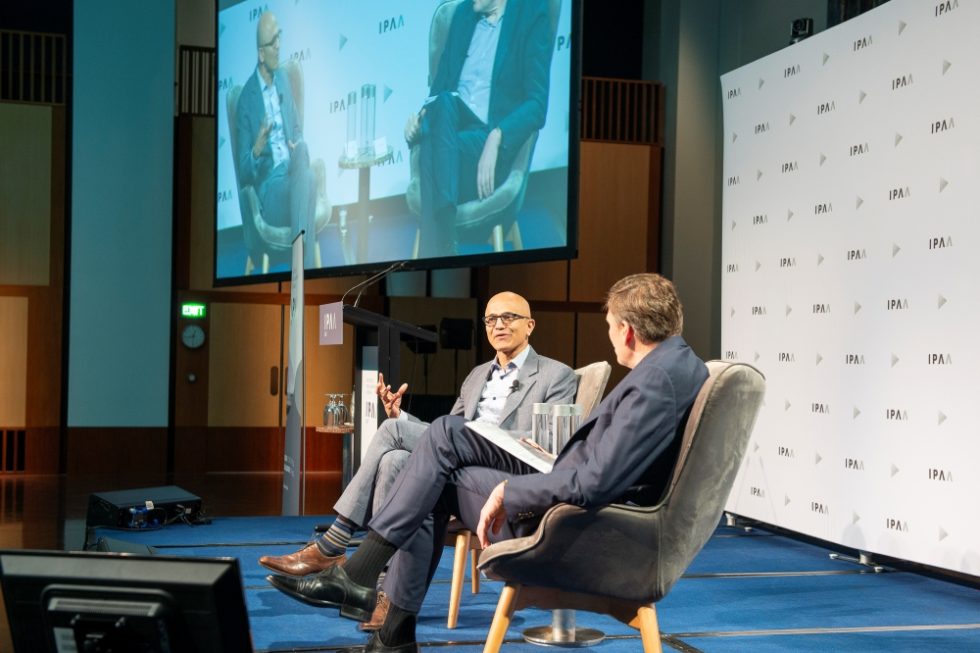
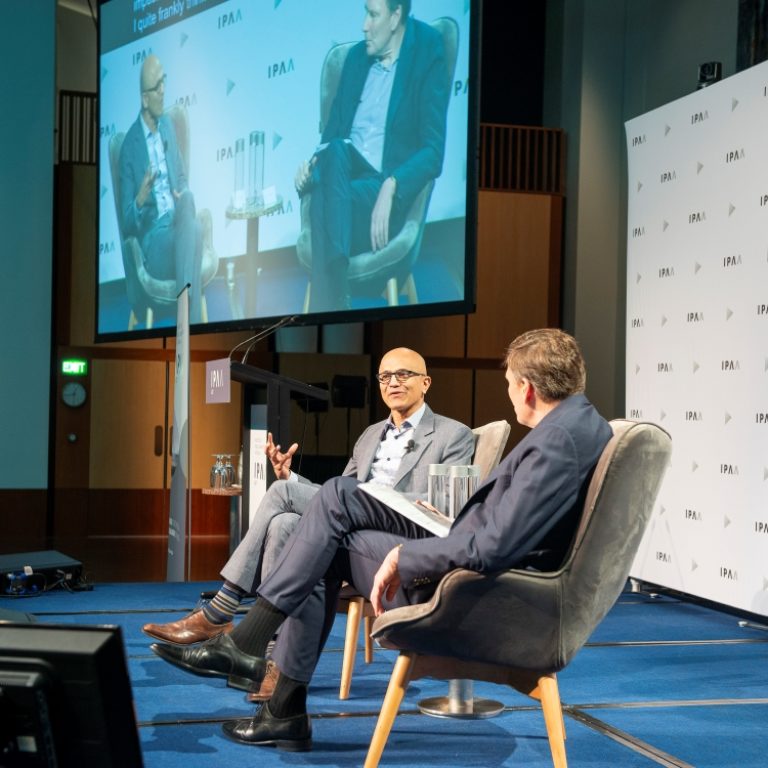
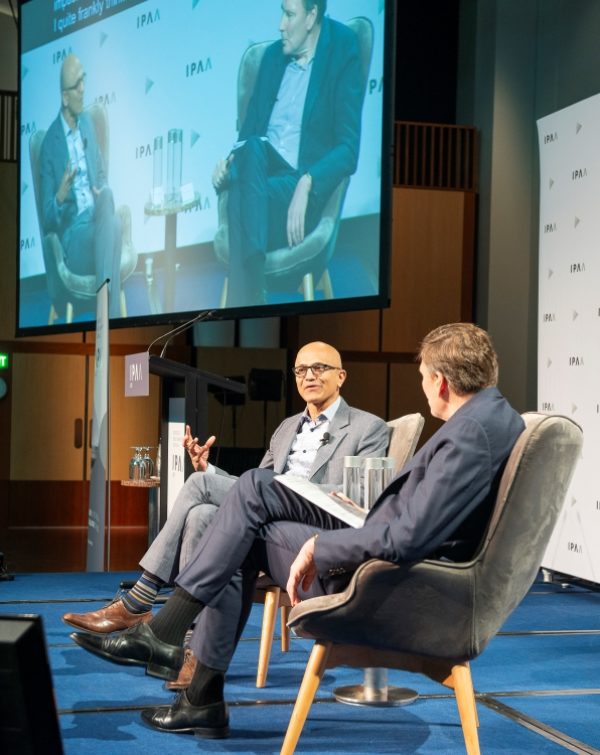
Delegates at the IPAA SA stream of the _southstart event heard from line-up of insightful speakers as they explored new insights regarding entrepreneurship, creativity and innovation in government organisations.
The event was officially opened by the Hon Steven Marshall MP with the IPAA SA delegates first hearing from speakers on the ways public sector institutions can ignite an entrepreneurial and creative spirit. Commissioner Erma Ranieri addressed the audience, outlining the aspirations of her office for assisting in developing a public sector that is outward looking, empowered and able to adapt. She was followed by keynote speaker Professor Rod Glover as he outlined the main findings of his ANZSOG report ‘Today’s Problems,Yesterday’s Toolkit’. He also explored the opportunities for public sector institutions to re-invent themselves to become more orientated towards innovation and problem-solving and to build entrepreneurial competencies.
Clare Mockler also addressed delegates, discussing the Adelaide City Council’s aspirations for innovative and responsive services and policies for the City of Adelaide and the capacity building required to achieve them. Following this Dr Matthew Butlin highlighted the opportunities and challenges for improving public sector productivity and its risk appetite, as well as the imperative that there is a culture of entrepreneurialism to imagine the innovations that lead to those improvements. To conclude the first session Jim Whalley, as the SA Government’s Chief Entrepreneur, shared his thoughts on what the public sector and the private sector entrepreneurial experience can teach each other, as well as how his office and the Advisory Board can assist with public sector balance accountability with entrepreneurialism.
During the second half of the event we explored the experiences of those helping to transition from current public sector norms to an environment where public entrepreneurs can thrive. Charles Landry first spoke to delegates on the theme of ‘Creative Bureaucracy’ across a variety of international jurisdictions, sharing the common experiences and emerging trends that are arising from this work. Doha Kahn, a year 12 student and activist then shared her first-hand experience on the subject, around the work and organisation of ‘School Strike 4 Climate’ movement. Following Ms Kahn, Craig Wilkins spoke to us from the perspective of the Conservation Council of SA, exploring the important role ‘social entrepreneurs’ have in promulgating and normalising the environmental policy agenda and opportunities for the public sector to appropriately engage with the aspirations of social movements and their entrepreneurs. In addition Kathryn Anderson outlined the imperative for both public sector and universities to building stronger ties in unlocking research knowleddge to inform public policy and reflect upon the role, skills and aptitudes required of public/social entrepreneurs in Universities and civil services to realise opportunities. Finally we were addressed by Greg Mackie OAM from the History Trust of SA where he drew upon current and previous roles with the Government of SA and his commercial (retail) and social entrepreneurial (Festival of Ideas) ventures,to reflect upon the importance of a vibrant public discourse in shaping the imagination, aspirations and behaviours of an effective and responsive public sector.
Each session was concluded with a panel style interview, where speakers were moderated by Prof Rod Glover and Charles Landry respectively, as they explored further insights around innovation, entrepreneurship and what it means for the SA public sector.
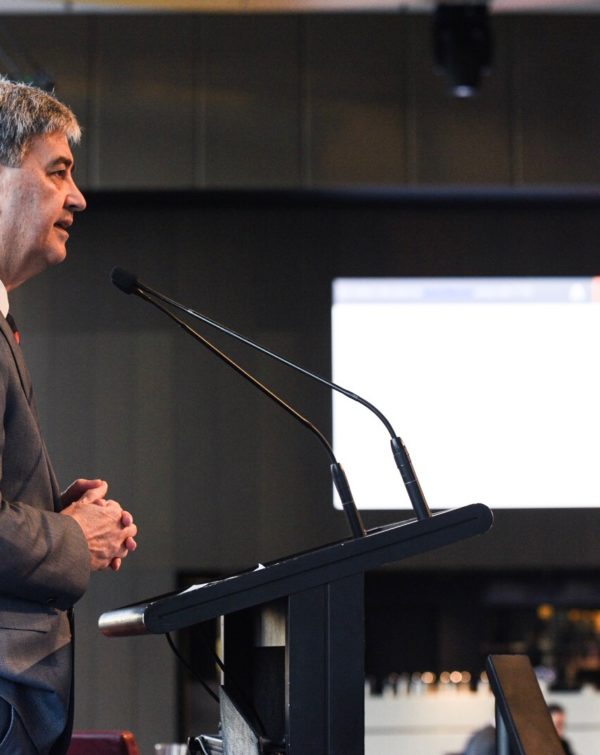
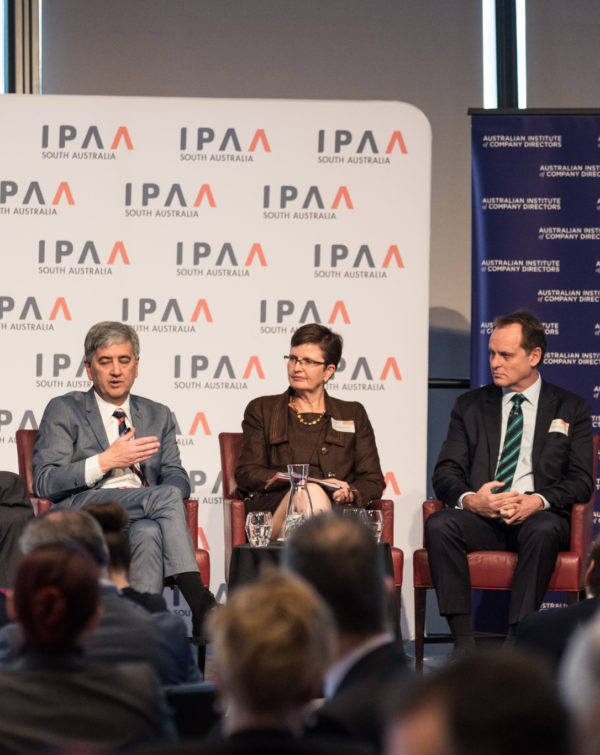
Building a New Civilization of Zero Poverty, Zero Unemployment and Zero Net Carbon Emissions : Ushering in A World of Three Zeroes through Social BusinessSpeaking as a former M&A lawyer and senior leader at a top tier fund manager, Grameen Australia is an independent replication of Grameen Bank which, in 2006 was jointly with its founder Professor Muhammad Yunus, awarded the 2006 Nobel Peace Prize for lifting millions of people out of poverty through microfinance. |
View Katrina Dunn’s presentation slides here.
View the transcript of the event here.
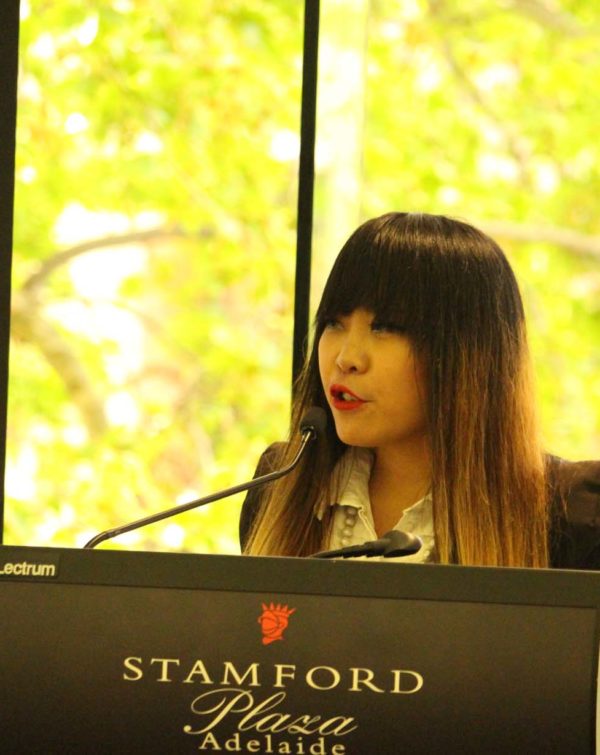
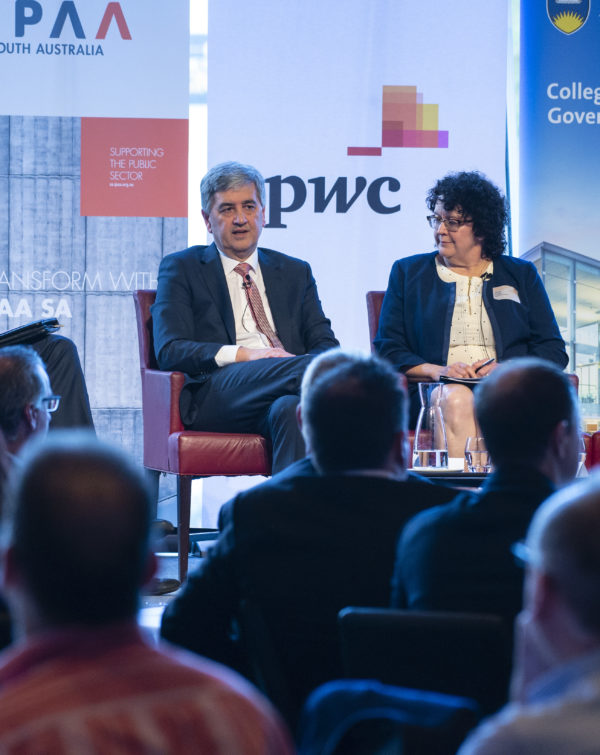
As part of Entrepreneurs’ Week 2018, IPAA hosted a forum to showcase examples of intrapreneurship in the South Australian public sector, and to explore emerging trends and challenges for achieving change, improving coordination and facilitating innovation.
IPAA Members joined IPAA SA and the Intrapreneurship Community of Practice (ICoP) for a snapshot of cutting edge intrapreneurial work by motivated innovators from around the world as part of Entrepreneurs Week 2018.
For the fourth year running the 2018 Intrapreneurship Forum was bigger and better, covering a wide range of Intrapreneurial topics, ideas and real time projects. Participants networked and discussed ideas with colleagues and experts, and attended exclusive workshops in a range of presentation formats.
This years keynote speaker was creative bureaucracy expert, Charles Landry.
In June 2018 IPAA SA commissioned a survey for the Intraprenuership forum, with results of this survey now available to view and download Here.
The forum featured thinking from leading practitioners in innovation. Speakers included:
IPAA SA will be placing a donation to the audience’s most popular charity of choice. Thank you to those who participated. Videos and slides will be available soon.
If you would like to be involved in the Intrapreneurship Community of Practice please email Tim Mares on tim.mares@sa.gov.au
View the live conversation on social media by visiting the hashtag #Intra2018 #EWeek2018. You can find us on Twitter @IPAASA and Facebook @IPAASouthAustralia.
| Date: | Thursday, 12 July 2018 |
| Time: | 8:30 am registration/networking, 9:15 am – 4:15 pm |
| Venue: | Hickinbotham Hall, National Wine Centre of Australia, Hackney Rd & Botanic Rd, Adelaide |
